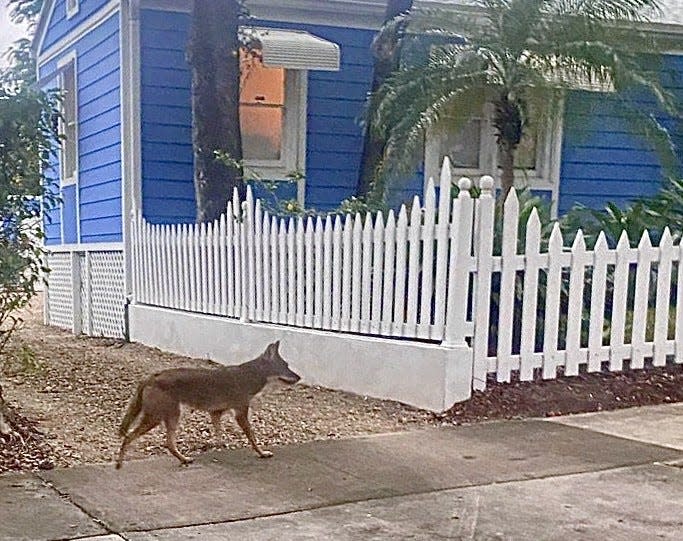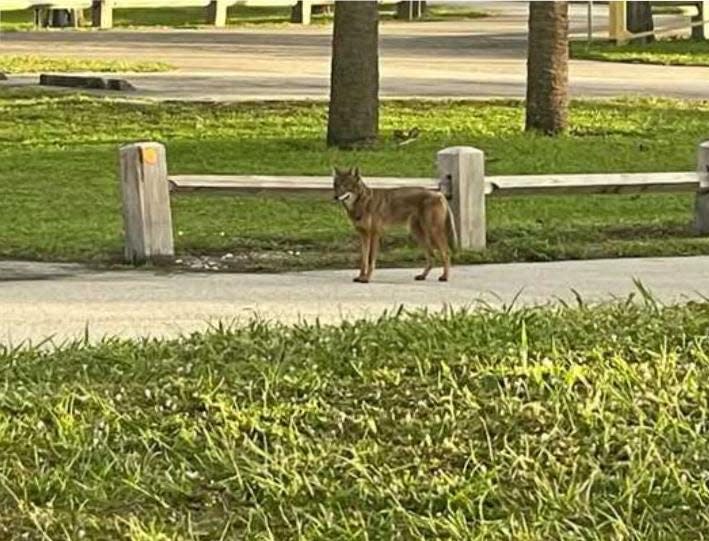Coyotes live throughout Florida and are common in cities where they may startle new residents
In the overgrown yards and scrubby sanctums of Florida’s gritty urban grids lives a wily denizen whose recent outings in a West Palm Beach neighborhood have raised eyebrows and harried a few nerves.
Talk of coyote sightings in areas near Dreher Park lit up community social-media pages this month with one long-time resident saying she’s noticed an increase in the usually aloof canines.
“I’ve seen it go from nothing to 'oh my God,' ” said Joanne Jaimedes, who has lived in a home that abuts Dreher Park in the southwest part of the city for nearly three decades. “It’s nightly activity at this point.”
Wildlife experts said there’s no need to be overly concerned. Coyotes, which are considered a naturalized species in Florida, are generally skittish and shy away from humans.

The fluffy-tailed predators help balance the ecosystem, eating opossums, raccoons, rabbits, rodents and foxes.
Coyotes are opportunistic feeders and will prey on cats and small dogs
But they are also opportunistic feeders. While not part of their normal diet, small, unmonitored household pets can become coyote fodder.
“Just like any animal, if you don’t know where your next meal is going to come from, you take what you can get,” said Amy Kight, executive director of Busch Wildlife Sanctuary near Jupiter. “Some of these animals have probably been born in someone’s backyard. To say they should be out in the woods, well, what woods are left anymore?”
New home for wildlife: See birds, bears, reptiles and more at the Busch Wildlife Sanctuary in Jupiter
Jaimedes said she found a mangled dead cat near her home that she suspects may have become coyote prey, and there have been a handful of reports of cats missing and small dogs attacked in western communities.
In 2015, at least eight cats were lost in the Thousand Pines community near West Palm Beach. That same year, trappers caught and killed two coyotes thought to have attacked two small dogs in the Timberwalk and Boca Winds neighborhoods west of Boca Raton.
A year later, coyotes were blamed for killing two pet goats in Jupiter Farms.
People are 'totally unaware' coyotes live in the city
“In an urban environment, they can cause a disturbance,” said Jaimedes, who noted a 2022 incident in California where a 2-year-old girl was attacked by a coyote that was later caught and euthanized. “As they lose their natural domain, they are spreading.”
She said she’s had flyers printed to let people know that there are coyotes in and around Dreher Park and that most people she talks to are “totally unaware” that they live in the city.
She’s also advocating for people to make their homes and yards less attractive to the coyotes by not feeding cats outside or leaving food outside overnight and keeping their trash cans secured.
Furry urban hunter: Foxes spotted in West Palm Beach's Flamingo Park Historic District but no reason to fear
“The nicer we make it for them, the more they will want to hang out,” Kight said. “We talk about how dangerous alligators are when they lose their fear of humans. It’s the same for other wildlife.”
Kight is not a fan of relocating coyotes. She said coyotes that get dropped off in a rural area are likely to have conflict with coyotes already established in the area. That can mean a “fight to the death,” or starvation.
How to keep coyotes away from your home and yard
FWC recommends hazing coyotes if they get too close. Hazing techniques include waving your arms and yelling, using an airhorn, shaking a can of pebbles or coins to make noise, opening, closing an umbrella and using motion-activated alarms or sprinklers.
Coyotes, which typically weigh between 20 and 35 pounds, have migrated to South Florida over the past several decades. According to a 2007 Florida Fish and Wildlife Conservation Commission report, they were found in just 18 counties in 1983, and those were mostly in the Panhandle.
By 1990 they were in at least 48 counties and have since been found in all 67 counties.
“We get coyote calls year-round,” Kight said. “If there’s been an increase in calls, it’s probably the amount of new people moving here from New York or New Jersey who have never experienced urban wildlife before.”

Dianne Sauve, a former director of Palm Beach County Animal Care and Control, said in an interview this year that she recommends against people walking their dogs on retractable leashes when there is a chance coyotes are in the area.
“If you’re taken by surprise, most of the time, the leash will spin away and come out of your hand,” she said. “We always say use a regular leash and wrap one loop around your hand.”
Jaimedes would also like to see more trash cans in Dreher Park.
“The coyotes are here now, and we need to change,” she said. “The only thing we have left to do is preventative measures.”
Kimberly Miller is a journalist for The Palm Beach Post, part of the USA Today Network of Florida. She covers real estate and how growth affects South Florida's environment. Subscribe to The Dirt for a weekly real estate roundup. If you have news tips, please send them to kmiller@pbpost.com. Help support our local journalism: Subscribe today.
This article originally appeared on Palm Beach Post: Coyotes in Florida: Tips to keep them away from your home and yard

